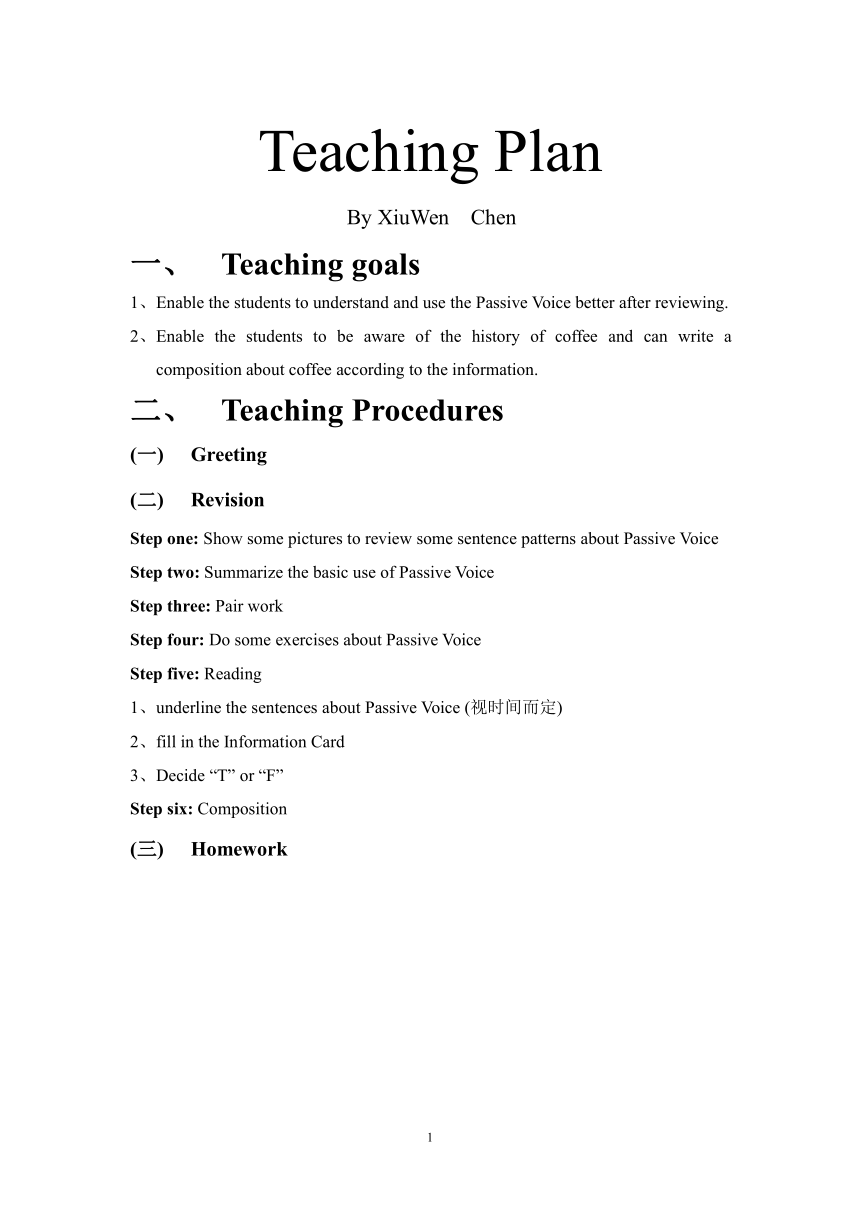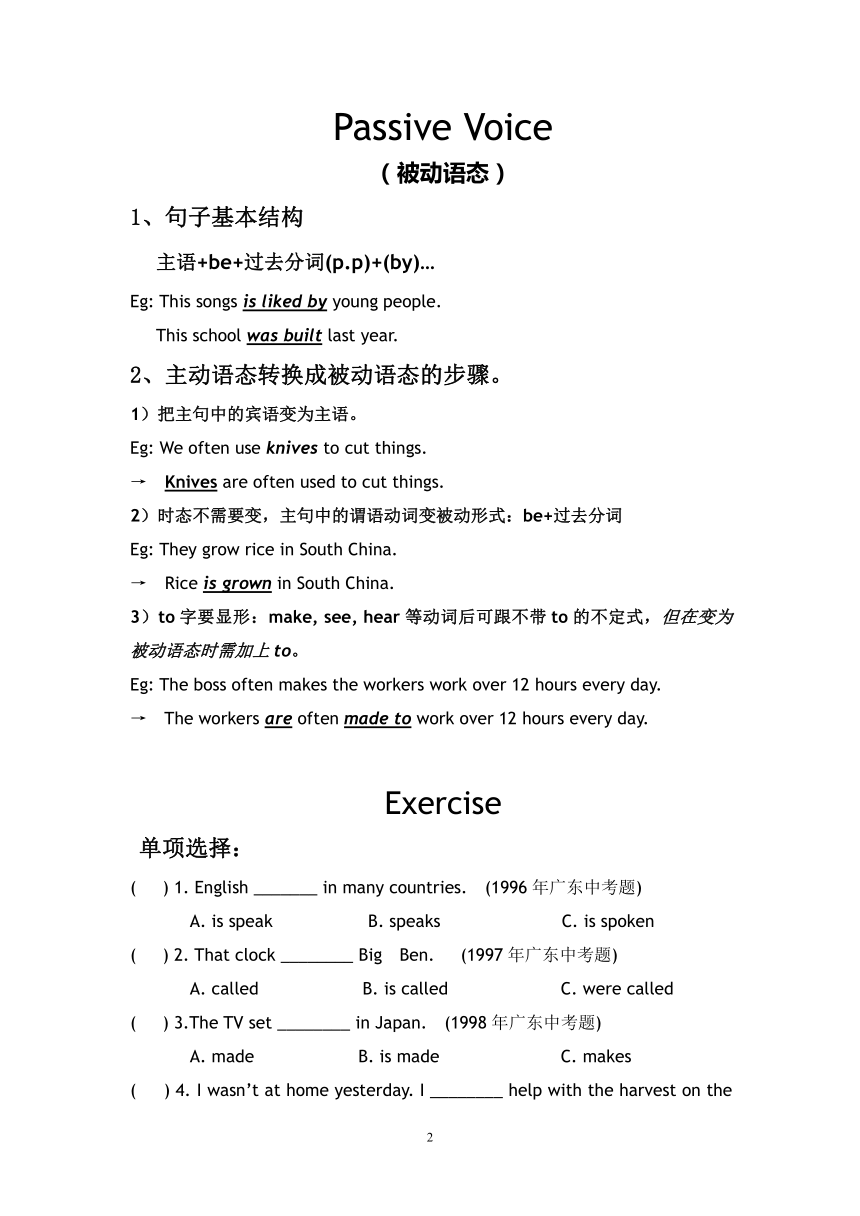被动语态复习[上学期]
图片预览


文档简介
Teaching Plan
By XiuWen Chen
1、 Teaching goals
1、 Enable the students to understand and use the Passive Voice better after reviewing.
2、 Enable the students to be aware of the history of coffee and can write a composition about coffee according to the information.
2、 Teaching Procedures
(1) Greeting
(2) Revision
Step one: Show some pictures to review some sentence patterns about Passive Voice
Step two: Summarize the basic use of Passive Voice
Step three: Pair work
Step four: Do some exercises about Passive Voice
Step five: Reading
1、 underline the sentences about Passive Voice (视时间而定)
2、 fill in the Information Card
3、 Decide “T” or “F”
Step six: Composition
(3) Homework
Passive Voice
(被动语态)
1、句子基本结构
主语+be+过去分词(p.p)+(by)…
Eg: This songs is liked by young people.
This school was built last year.
2、主动语态转换成被动语态的步骤。
1)把主句中的宾语变为主语。
Eg: We often use knives to cut things.
→ Knives are often used to cut things.
2)时态不需要变,主句中的谓语动词变被动形式:be+过去分词
Eg: They grow rice in South China.
→ Rice is grown in South China.
3)to字要显形:make, see, hear等动词后可跟不带to的不定式,但在变为被动语态时需加上to。
Eg: The boss often makes the workers work over 12 hours every day.
→ The workers are often made to work over 12 hours every day.
Exercise
单项选择:
( ) 1. English _______ in many countries. (1996年广东中考题)
A. is speak B. speaks C. is spoken
( ) 2. That clock ________ Big Ben. (1997年广东中考题)
A. called B. is called C. were called
( ) 3.The TV set ________ in Japan. (1998年广东中考题)
A. made B. is made C. makes
( ) 4. I wasn’t at home yesterday. I ________ help with the harvest on the farm.(2002年广东中考题)
A. asked to B. was asked to C. was asking
( ) 5. School football games _________ on Friday evenings. (2002年北京中考题)
A. holds B. held C. are held
完成句子:
1、这首歌深受同学们的喜爱。(2002年广东中考题)
This song ________________the students.
2、这个丢失的女孩今早被找到了。(1999年广东中考题)
The lost girl ________________ this morning.
3、这个桌子是木头做的。(2001年广东中考题)
The desk _________________ wood.
4、这些蔬菜每天都要浇水。(1998年广东中考题)
These vegetables _______________ every day.
5、这间工厂建于1980年。(2003年上海中考题)
This factory ______________ in 1980.
Reading
Have you ever drunk coffee It is so popular that millions of people are drinking it. And it has been a part of life for thousands of years. Do you know the story of coffee and how it was discovered
There is an old story that says coffee was discovered in Africa a long, long time ago. One day, a farmer was watching his goats, and he saw them eat some small berries from a plant. After the goats ate the berries, they became very active. The farmer often felt tired, so he decided to try the berries, too. Surprisingly, he didn’t feel tired any more. Coffee plants were thus discovered.
Then coffee was taken from Africa to Arabia, and there it was first used as medicine. The Arabs kept coffee a secret for many years. Later, coffee came to Turkey, then Italy, and then France. From Europe, the coffee plants was taken to America. People found that coffee plants grew well in many parts of South America, so large coffee farms were started, and many coffee plants were grown. On these farms, coffee beans were picked from the plants by hand. Then the beans were dried and prepared for the market. Different coffee beans were mixed together to produce different kinds of coffee. Coffee was sent all over the world, and soon became very popular.
Information Card
1、Where was coffee discovered
2、Who was coffee discovered by?
3、Was coffee first used as medicine in Arabia
4、Why were large coffee farms started in many parts of South America
5、What is the article about
Decide “True ( T )” or “False ( F )”:
( ) 1. Coffee was discovered in America a long, long time ago.
( ) 2. A farmer picked some berries to eat and fed the goats with them.
( ) 3. Coffee was first used as medicine in Arabia.
( ) 4. Coffee was taken from Arabia to America and then to Europe.
( ) 5. Large coffee farms were started in South America because coffee plants grew well there.
书面表达
假如你是一名初中英语老师,请你根据以上信息,备一段大约80字左右的课,告诉同学们有关咖啡的由来。
________________________________________________________________________________________________________________________________________________________________________________________________________________________________
PAGE
4
By XiuWen Chen
1、 Teaching goals
1、 Enable the students to understand and use the Passive Voice better after reviewing.
2、 Enable the students to be aware of the history of coffee and can write a composition about coffee according to the information.
2、 Teaching Procedures
(1) Greeting
(2) Revision
Step one: Show some pictures to review some sentence patterns about Passive Voice
Step two: Summarize the basic use of Passive Voice
Step three: Pair work
Step four: Do some exercises about Passive Voice
Step five: Reading
1、 underline the sentences about Passive Voice (视时间而定)
2、 fill in the Information Card
3、 Decide “T” or “F”
Step six: Composition
(3) Homework
Passive Voice
(被动语态)
1、句子基本结构
主语+be+过去分词(p.p)+(by)…
Eg: This songs is liked by young people.
This school was built last year.
2、主动语态转换成被动语态的步骤。
1)把主句中的宾语变为主语。
Eg: We often use knives to cut things.
→ Knives are often used to cut things.
2)时态不需要变,主句中的谓语动词变被动形式:be+过去分词
Eg: They grow rice in South China.
→ Rice is grown in South China.
3)to字要显形:make, see, hear等动词后可跟不带to的不定式,但在变为被动语态时需加上to。
Eg: The boss often makes the workers work over 12 hours every day.
→ The workers are often made to work over 12 hours every day.
Exercise
单项选择:
( ) 1. English _______ in many countries. (1996年广东中考题)
A. is speak B. speaks C. is spoken
( ) 2. That clock ________ Big Ben. (1997年广东中考题)
A. called B. is called C. were called
( ) 3.The TV set ________ in Japan. (1998年广东中考题)
A. made B. is made C. makes
( ) 4. I wasn’t at home yesterday. I ________ help with the harvest on the farm.(2002年广东中考题)
A. asked to B. was asked to C. was asking
( ) 5. School football games _________ on Friday evenings. (2002年北京中考题)
A. holds B. held C. are held
完成句子:
1、这首歌深受同学们的喜爱。(2002年广东中考题)
This song ________________the students.
2、这个丢失的女孩今早被找到了。(1999年广东中考题)
The lost girl ________________ this morning.
3、这个桌子是木头做的。(2001年广东中考题)
The desk _________________ wood.
4、这些蔬菜每天都要浇水。(1998年广东中考题)
These vegetables _______________ every day.
5、这间工厂建于1980年。(2003年上海中考题)
This factory ______________ in 1980.
Reading
Have you ever drunk coffee It is so popular that millions of people are drinking it. And it has been a part of life for thousands of years. Do you know the story of coffee and how it was discovered
There is an old story that says coffee was discovered in Africa a long, long time ago. One day, a farmer was watching his goats, and he saw them eat some small berries from a plant. After the goats ate the berries, they became very active. The farmer often felt tired, so he decided to try the berries, too. Surprisingly, he didn’t feel tired any more. Coffee plants were thus discovered.
Then coffee was taken from Africa to Arabia, and there it was first used as medicine. The Arabs kept coffee a secret for many years. Later, coffee came to Turkey, then Italy, and then France. From Europe, the coffee plants was taken to America. People found that coffee plants grew well in many parts of South America, so large coffee farms were started, and many coffee plants were grown. On these farms, coffee beans were picked from the plants by hand. Then the beans were dried and prepared for the market. Different coffee beans were mixed together to produce different kinds of coffee. Coffee was sent all over the world, and soon became very popular.
Information Card
1、Where was coffee discovered
2、Who was coffee discovered by?
3、Was coffee first used as medicine in Arabia
4、Why were large coffee farms started in many parts of South America
5、What is the article about
Decide “True ( T )” or “False ( F )”:
( ) 1. Coffee was discovered in America a long, long time ago.
( ) 2. A farmer picked some berries to eat and fed the goats with them.
( ) 3. Coffee was first used as medicine in Arabia.
( ) 4. Coffee was taken from Arabia to America and then to Europe.
( ) 5. Large coffee farms were started in South America because coffee plants grew well there.
书面表达
假如你是一名初中英语老师,请你根据以上信息,备一段大约80字左右的课,告诉同学们有关咖啡的由来。
________________________________________________________________________________________________________________________________________________________________________________________________________________________________
PAGE
4
同课章节目录
- 词法
- 名词
- 动词和动词短语
- 动词语态
- 动词时态
- 助动词和情态动词
- 非谓语动词
- 冠词
- 代词
- 数词和量词
- 形容词副词及其比较等级
- 介词和介词短语
- 连词和感叹词
- 构词法
- 相似、相近词比较
- 句法
- 陈述句
- 一般疑问句和否定疑问句
- 特殊疑问句及选择疑问句
- 反意疑问句
- 存在句(There be句型)
- 宾语从句
- 定语从句
- 状语从句
- 主谓一致问题
- 简单句
- 并列句
- 复合句
- 主谓一致
- 主、表语从句
- 名词性从句
- 直接引语和间接引语
- 虚拟语气
- 感叹句
- 强调句
- 倒装句
- 祈使句
- 句子的成分
- 句子的分类
- 题型专区
- 单项选择部分
- 易错题
- 完形填空
- 阅读理解
- 词汇练习
- 听说训练
- 句型转换
- 补全对话
- 短文改错
- 翻译
- 书面表达
- 任务型阅读
- 语法填空
- 其他资料
